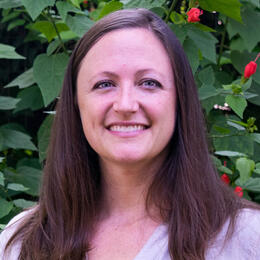Audubon South Carolina is pleased to introduce the newest member of our team: John Jay Audubon! Named after our organization’s namesake, John J. Audubon, this imprinted non-releasable Blue Jay, or Cyanocitta cristata, will serve as our new feathered educational ambassador.
In addition to helping our team teach new audiences about the beautiful and intelligent Corvid family of birds, John Jay’s backstory will also serve as a cautionary tale for well-meaning individuals who happen across a baby bird out of its nest.
Blue Jays are open cup nesters, meaning they use the stereotypical open nests made of twigs in the crook of a tree. These classic open cup nests are advantageous in some ways, such as the ability they provide a bird to pick a location for their nests. Yet the design has disadvantages as well, including the fact that they are not as stable or sheltering as a cavity nest. This is where our little friend John Jay ran into a problem. Like many birds, young Blue Jays grow quickly, and a twig nest can become crowded as the ravenous nestlings grow. John Jay may have been wrestling for some elbow room with his siblings when he fell from the nest. Onlookers saw the bird on the ground and did what they thought was best: they adopted it.
What these individuals didn’t realize was that, when you feed a young bird, you assume the role of “mom” in that bird’s eyes. The people who found John Jay fed the young bird long enough that it became imprinted and habituated to people, making renesting attempts unsuccessful. An imprinted bird looks to humans as a source of food, and also as potential mates or rivals. Imprinted wild birds, like our John Jay, aren’t shy when it comes to wooing a human mate, chasing off human rivals, or snatching food out of your hand at the park. So, for the sake of both the bird’s safety and the public’s safety, imprinted birds are non-releasable.
After acquiring the proper federal permits from the U.S. Fish and Wildlife Service and state permits from the South Carolina Department of Natural Resources, Audubon South Carolina agreed to house and care for John Jay. We will use the bird for educational programming related to bird ecology, anatomy, behavior, intelligence, ecology and conservation.
When not traveling to offsite programs, John Jay will live at our Audubon Center at Francis Beidler Forest in Harleyville, S.C, where he will greet visitors and school groups. He will reside in beautiful and spacious aviary, loving built by--and named in honor of--our recently retired center manager, Mike Dawson.
Using a live bird for educational programming can be the spark of inspiration that people need to begin noticing and caring about birds in their yards and in faraway places alike. We hope that the up-close experience of meeting our newest addition will facilitate greater understanding and appreciation of birds--while encouraging more people to use bird safe practices in their own lives, such as preventing window strikes, keeping cats indoors, and planting native plant species that support and conserve the feathered friends we love.





